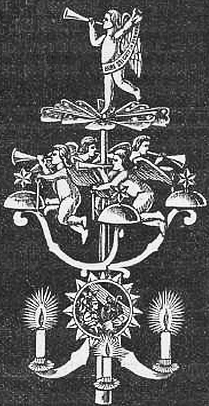Angel chimes
Angel chimes, also known as angel-abra, are a form of Christmas decoration popular in Europe and North America.[1] They apparently have the same origins as the Christmas pyramid, which functions on the same principle. They differ from these, primarily, in being mass-produced from metal and having bell-ringing angels, whereas Christmas pyramids are usually crafted from wood and do not necessarily have bells.

In 2007, a rare 1920s metal Christmas angel chime tree topper was auctioned online through eBay.[2] Its box was labeled "electric chimes".
Function
Angel chimes have candle holders at the base which provide heat which turns a turbine at the top, which powers a series of trumpet-holding angel figures which "fly" around in a circle, striking bells beneath them. They usually have other decorative motifs, such as the Star of Bethlehem or a creche.
History

The angel chimes tradition in the United States started about 100 years ago[3] when immigrant families brought German angel chimes. The earliest known patent for an angel chime was filed by Walter Stock of the German toy firm Adrian & Stock.[4] The pre-World War II German-made chimes were usually made of tin and featured lithography.
In Sweden
Christmas angel chimes are popularly known as "änglaspel" (angel carillon) in Sweden.[5] After World War II, Swedish-made chimes became popular in both Europe and North America. These brought a simpler aesthetic in brass.
In Denmark
They are known as "Engle Spil" (Angel Bells) in Denmark.
In Asia
More recently, angel chimes manufactured in China has come to dominate the export market. The design now includes spinning candles.
In popular culture
There are a number of songs written about angel chimes, which include Angel's song, the Christmas Chimes. The sheet music has been compiled at the performing arts encyclopedia[6] of the United States Library of Congress up to the present day.
Nina Raine uses Angel Chimes in her play, Rabbit.
References
- A Special Collection: Candle Powered Chimes Retrieved 28 June 2013
- Ultimate Antiques and Collectibles Price Guide. Retrieved 28 June 2013
- Eric Holzenberg Christmas-themed chimes collection Retrieved 28 June 2013
- Adrian & Stock patent, 1906 Retrieved 28 June 2013
- A Traditional Swedish Christmas at Nordstjernan. Retrieved 28 June 2013
- Angel's song, The [from] Christmas chimes sheet music at the US Library of Congress Retrieved 28 June 2013